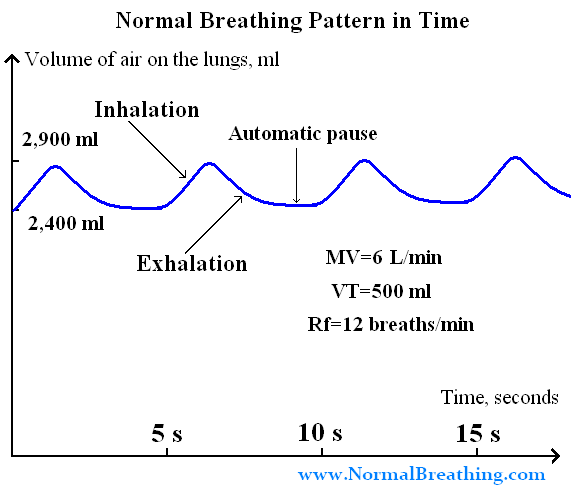- Updated on September 13, 2020
![]() By Dr. Artour Rakhimov, Alternative Health Educator and Author
By Dr. Artour Rakhimov, Alternative Health Educator and Author
- Medically Reviewed by Naziliya Rakhimova, MD
Normal Breathing Pattern (Normal Respiration Cycle)
 Modern physiology textbooks suggest the following parameters of the normal breathing pattern (normal respiration) at rest for healthy subjects:
Modern physiology textbooks suggest the following parameters of the normal breathing pattern (normal respiration) at rest for healthy subjects:
– inhalation is 1.5-2 s
– exhalation is 1.5-2 s
– an automatic pause of almost no breathing is 2 s
– tidal volume (the depth of inhalation) is 500-600 ml
– breathing frequency (or Rf – respiratory frequency or respiratory rate) is 10-12 breaths/min.
The international physiological norm for the breathing pattern at rest is 6 L/min (for a 70-kg man). Normal stress-free breath holding time after usual exhalation (that correlates with body-oxygen content) is 40 s. References for medical textbooks that provide these values are below.
normal breathing pattern cycle chart

This chart shows 4 normal breathing pattern of the normal respiration pattern for normal subjects:
inhalation (the upward lines), exhalation (the downward lines) and automatic pause
(the almost horizontal lines) accompanied by relaxation of all breathing muscles.
Features of the normal breathing pattern
 Apart from the numbers, there are many important qualities of a normal respiratory pattern. Their breathing is slow, regular, nasal only, diaphragmatic, invisible and inaudible (no panting, no wheezing, no sighing, no yawning, no sneezing, no coughing, no deep inhalations or exhalations). They take small inhalations and then relax for the exhalation. The exhalation is followed by an automatic pause (or period of no breathing) of about 2 s. The normal body oxygen level is about 40 s for the medical norm and 60 s for the Buteyko norm.
Apart from the numbers, there are many important qualities of a normal respiratory pattern. Their breathing is slow, regular, nasal only, diaphragmatic, invisible and inaudible (no panting, no wheezing, no sighing, no yawning, no sneezing, no coughing, no deep inhalations or exhalations). They take small inhalations and then relax for the exhalation. The exhalation is followed by an automatic pause (or period of no breathing) of about 2 s. The normal body oxygen level is about 40 s for the medical norm and 60 s for the Buteyko norm.
Most of the job of inhalation (up to 80-90%) is done by the diaphragm, the main breathing muscle. Exhalation is passive and is accompanied by the relaxation of all breathing muscles. These parameters of the normal respiration cycle were established about 100 years ago. Published medical articles found that in the 1920-1930s, normal subjects were breathing even less air at rest than the medical norm (6 L of air per minute).
Most modern people breathe more than the norm
Do you know that over 90% of modern “normal subjects” breathe at rest much more air than the medical norms? One page of this site has a historical chart based on 24 medical publications. It shows changes in respiratory patterns for nearly 100 years. The link to this page is provided right below here as your bonus content.
You can find this graph on the Homepage of this site.
[/sociallocker]
Medical textbooks references
Ganong W, Review of medical physiology; 15th ed., 1995, Prentice-Hall Int., London.
Guyton A, Physiology of the human body; 6th ed., 1984, Suanders College Publ., Philadelphia.
McArdle W, Katch F, Katch V, Essentials of exercise physiology (Second edition); Lippincott, Williams and Wilkins, London 2000.
Straub N, Section V, The Respiratory System, in Physiology, editors. R Berne & M Levy, 4th edition, Mosby, St. Louis, 1998.
Summary of values useful in pulmonary physiology: man. In the Section: Respiration and Circulation, ed. by P Altman & D Dittmer, 1971, Bethesda, Maryland (Federation of American Societies for Experimental Biology).

